#ramon magsaysay
Text
#Rice and the #LawOfSupplyAndDemand
#Economics #RicePriceCap #Philippines
A #DOF Usec who posted about rice price cap was ‘forced to resign’ because it went against basic economic concepts.
I remember a very popular former Philippine Pres. #RamonMagsaysay who was the subject of some jokes – that he was going to repeal the law of supply and demand (a fundamental economic principle that explains when supply exceeds demand for a good or service, prices fall. When demand exceeds supply, prices tend to rise).
instagram
0 notes
Text
Ela Bhatt
A Lawyer and a Social Worker(7 September 1933 – 2 November 2022)
Ela Bhatt efforts for the rights of women, particularly those in the informal sector, have left an incredible impact on society. Bhatt’s work with the Self-Employed Women’s Association (SEWA) and her work transformed the lives of countless women and communities across India.
Self-Employed Women’s Association: Under Bhatt’s…

View On WordPress
#best ngo#Bhatt#Ela#girl#impact#Ramon Magsaysay#RSKS#RSKSIndia#Self-Employed Women&039;s Association#SEWA#Social Worker#support#United Nations#women
0 notes
Text
Moonies Support Vigilante Violence in the Philippines Around 1986/1987

▲ Pictured: A banner from a 2017 Alsa Masa gathering. Though Alsa Masa is not what it once was, many vigilante and paramilitary organizations have descended from Alsa Masa and taken up their mantle, such as Davao Death Squad or DDS.
Excerpts from Belina A. Aquino's "The Philippines in 1987: Politics of Survival.”
Human Rights Group Confirms Vigilante Reports
In mid-May, an international fact-finding team headed by former US Attorney General Ramsey Clark visited the Philippines to look into the existence and activities of armed vigilantes. The team, composed mainly of human rights advocates, interviewed people in Luzon, Mindanao, Cebu, and Negros. Its findings included: (1) a rapidly growing vigilante movement that has killed, tortured, threatened, or otherwise harassed civilians who are mostly poor farmers, workers, and other individuals who have advocated land reform, wage increases for workers, and withdrawal of the US bases; (2) Philippine military and civilian officials are endorsing and even arming some of these vigilante groups; (3) foreign organizations like the Unification Church-affiliated associations for the Unification of the Societies of the Americas, the WACL, and the World Anti-Communist Crusade, are actively engaged in organizing the movement; and (4) clear evidence of sophisticated methods of counterinsurgency and "low-intensity conflict" (LIC) operating in the Philippines, including direct military action done by Philippine forces with US technical assistance.
One of the team members was Ralph McGehee, a former CIA agent in Asia who wrote a book, Deadly Deceits, about his 25 years with the agency. He had served as a special liaison officer of the Vietnam Special Forces, which were really assassination squads assigned to liquidate communists in the villages. McGehee noticed "direct parallels" between the Vietnam experience and the current Philippine situation. Among these parallels are the "search and destroy" operations; "free-fire zones," and forcing rural people into the population centers to deny the insurgents a mass base. The Alsa Masa and NAKASAKA had counterparts in the Vietnamese reconnaissance units.
McGehee also saw the possibility that a ''version of the CIA's Phoenix Program - a coordinated military, police, and civilian effort to destroy Vietnamese revolutionary forces through assassination squads trained by special forces with the CIA - is now being employed in the country." He pointed out that Lt. Col. Calida, the so-called "godfather" of Alsa Masa had undergone training in 1971-72 at Fort Bragg in North Carolina, considered the counterinsurgency training center in the US. McGehee further noted that the mushrooming of anti-Communist literature was a normal component of CIA "media operations." Calida denied McGehee's allegations.
These observations on possible CIA involvement in Philippine affairs in the post-Marcos period are not far-fetched. At the height of the Huk movement in the fifties, CIA operative Edward Lansdale put together a plan combining military action, economic benefits, and political strategy to defeat the insurgency with the help of Philippine officials like Ramon Magsaysay. More recently, the CIA knew of the corrupt activities of Marcos as early as 1969 and his plan to declare martial law in 1972. Since Aquino assumed power, Manila media circles have speculated on the presence of about 115 CIA agents in the Philippines. The hard evidence, of course, cannot be produced, but it would strain credulity to believe that there is no CIA activity in the country today. Trained in covert action and disinformation, CIA officers are not about to give away their agency secrets. Like McGehee, they get to tell what they did in some of these countries after they retire.
Religion and Politics
This discussion of the emergence of right-wing fanaticism in the Philippines would not be complete without mentioning the corresponding phenomenal rise of religious fundamentalism in many parts of the country today. Banners announcing prayer meetings, talk shows, workshops, and seminars by such fundamentalist sects like Campus Crusade for Christ, 700 Club, Assemblies of God, World Vision International, the Billy Graham Evangelistic Association, and the much-talked about CAUSA, were commonplace during the year, particularly in Metro Manila and the bigger cities. The Unification Church even sponsored a visit to the Philippines in August of Msgr. Bismark Carballo, a Nicaraguan priest exiled by the Sandinistas for his support of the US-backed "contras." The most visible fundamentalist preachers like Billy Graham, Jerry Falwell, Jimmy Swaggart and Pat Robertson have either visited the Philippines or have regular telecasts in the country.
The Carballo visit inspired a Maryknoll cleric, Fr. Thomas Marti, who has long worked in the Philippines, to research the connections between some of these fundamentalist groups and the right-wing networks in the U.S. Marti found that the Reagan administration sought the help of CAUSA International to support US policy in Nicaragua. It might be mentioned that the Moonies and CAUSA have conducted expense-paid seminars and conferences in Washington, D.C.; Manila and other places, inviting well-known names in academic, religious and political circles. Among the CAUSA's top brass are Cleon Skousen, a Mormon Church leader, Douglas MacArthur II, and Bo Hi Pak, the chairman who has acknowledged CIA funding. This is just another form of counter-insurgency, but it tries to minimize direct military intervention in favor of small "grassroots" efforts combining socio-economic, civic action, psychological & political objective.
It seems, Marti concludes, that the combination of the political and religious right is intent on fomenting a "Red scare" in the Philippines, as they have done in Latin America, to undermine the earlier efforts of the Aquino government to come to a negotiated settlement with the NDF/CPP/NPA. Noticeable itself is the government's drift to the right and Aquino herself, while cautioning against unrestrained vigilante activities, has not discouraged them. In a visit to Davao City, which some of her supporters considered a "misjudgment," Aquino told members of the Alsa Masa "they were a model in the battle against the 18-year communist insurgency.”
RELATED:
- Moonies demanded $2,000 from Koreans who wanted to have Filipinas as “housemaids and sex partners.”
- In 1985 the Washington Times sponsored a fund for the Contras who committed atrocities, and trafficked drugs to the US
- CounterSpy: Moonies Move on Honduras (1983)
- One Account of Being Trafficked into Prostitution Through UC “Blessing”
- Human trafficking is despicable. Here is one Filipina’s story of slavery in the Unification Church
- The UC should be held responsible for supplying weapons that killed young Filipino activists
- The Unification Church and KCIA: Some Notes on Bud Han, Steve Kim, and Bo Hi Pak
- The Unification Church and the KCIA – ‘Privatizing’ covert action: the case of the UC
- The Broad Counterinsurgency Strategies of the US in the 80s, and a Glimpse into the UC’s Role
- UNESCO Report: Korean-Filipino marriages under the UC sparked controversy and animosity
#unification church#causa#anti-communism#bo hi pak#General Douglas MacArthur#Unification church in the philippines#the philippines#Philippines#nicaragua#CIA#phoenix program#Ramon Magsaysay#violence#right-wing politics#politics#counterinsurgency#kcia#parapolitical#political
0 notes
Text



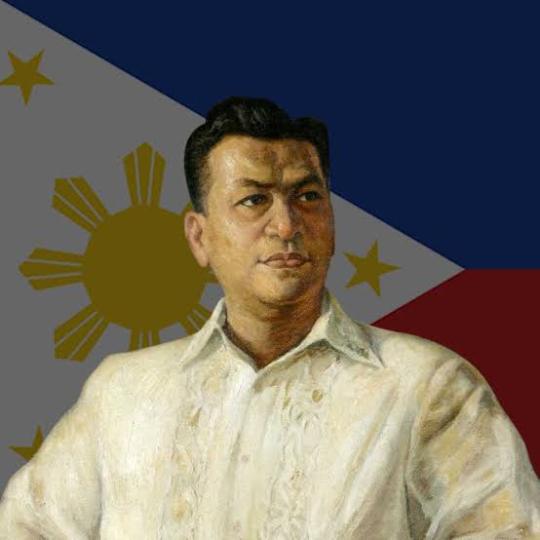
Today is 17th of March.
Today is Saint Patrick's Day, Campfire Girls Day, National Corned Beef and Cabbage Day, Ramon Magsaysay Memorial Day.
#saint patricks day#campfire girls day#national corned beef and cabbage day#ramon magsaysay memorial day
2 notes
·
View notes
Text
Định đến Việt Nam 3 tháng, bác sĩ Hattori đã đi 20 năm, đem lại ánh sáng cho gần 20.000 người
Định đến Việt Nam 3 tháng, bác sĩ Hattori đã đi 20 năm, đem lại ánh sáng cho gần 20.000 người
Chuyến đi tưởng 3 tháng của bác sĩ Hattori Tadashi vào năm 2002 rốt cuộc kéo dài đến 20 năm, lấy đi của ông không ít thứ nhưng đem lại ánh sáng cho gần 20.000 người. Ông không lấy bất cứ tiền công nào, thậm chí còn bỏ tiền túi cho người bệnh.
Bác sĩ Hattori Tadashi nhận hoa chúc mừng từ bà Tôn Thị Kim Thanh, chủ tịch Hội Nhãn khoa Việt Nam, trong sự kiện ở Đại sứ quán Nhật Bản tại Hà Nội ngày…

View On WordPress
#bác sĩ Hattori ở lại 20 năm#bác sĩ thiện nguyện#cứu giúp 20.000 người Việt khỏi mù#Giải thưởng Ramon Magsaysay
0 notes
Note
i realize this is a very broad question, but would you happen to know any good books/other sources about Filipino history? I've wanted to do reading on the subject for a while now, but I'm not sure where to start or what's worth checking out
The History of the Filipino People by Teodoro Agoncillo is a good place to start (it was also my highschool text book). It was published in 1960 so you're not gonna find much info about the dictatorship era or about how the Americans used the Philippines as a testing ground for various political campaigns (the presidency of Ramon Magsaysay for example, won on a campaign backed and designed by the US), but it details the Philippines' colonial history of 300+ years of Spanish Rule, 30 of American rule, and then 3 of Japanese rule. I can't remember if it's pretty biased towards the American occupation (as many of our history books are) but I wouldn't be surprised if it is.
I'm asking some friends for suggestions on some more modern history books that I can also send you. There's a lot of historical revisionism to wade through, and not all of our books are written in English.
31 notes
·
View notes
Text
Holidays 3.17
Holidays
Buy Women Owned Day
Camp Fire Girls Day
Children’s Day (Bangladesh)
Day of Comics & Comic Books (Spain)
Doctor-Patient Trust Day
Ennensaii (Kyoto, Japan)
Evacuation Day (Suffolk County, MA)
Glider Day
Kustonu Diena (No Planting Day; Ancient Latvia)
Mobilization Employee Day (Ukraine)
National Children Day (Bangladesh)
National Muay Thai Day
National SBCD Day
National Slime Day
Patrick Star Day (SpongeBob)
Psyche Asteroid Day
Ramon Magsaysay Memorial Day (Philippines)
Rubber Band Day
Sheikh Mujibur Rahman Day (Bangladesh)
Social Care Day of Remembrance & Reflection (UK)
St. Carl’s Day (Sacrilege Brewing)
St. Patrick's Day (a.k.a. ...
Corned Beef & Cabbage Day
Green Ribbon Day
Irish Coffee Day
Irish Stout Day
Lá Fhéile Pádraig
St. Catrick’s Day
Submarine Day [also 4.11]
317 Day (Indiana)
Vanguard I Day
Violet Day
Wood Anemone Day (French Republic)
World Maritime Day
World Shale Energy Day
Food & Drink Celebrations
Irish Coffee Day
Irish Stout Day
National Corned Beef and Cabbage Day
National Irish Beer Day
National Irish Food Day
3rd Sunday in March
American Chocolate Week begins [3rd Sunday]
Buzzard Sunday (a.k.a. National Buzzard Day) [Sunday after 15th]
Root Canal Awareness Week begins [3rd Sunday]
Silly Sunday [3rd Sunday]
Weekly Holidays beginning March 17 (3rd Week)
American Chocolate Week [3rd Full Week]
Clutter Awareness Week [3rd Full Week]
Consider Christianity Week [begins 2nd Sunday before Easter]
International Goof Off Week [3rd Full Week]
Jobs for Teens Week [3rd Full Week]
National Agriculture Week [3rd Full Week]
National Animal Poison Prevention Week [3rd Full Week]
National Anonymous Giving Week [3rd Full Week]
National Bubble Week [1st Week of Spring]
National Button Week [3rd Full Week]
National Clean Out Your Closet Week [3rd Full Week]
National Fix a Leak Week [3rd Full Week]
National Inhalants and Poisons Awareness Week [3rd Full Week]
National Introverts Week [3rd Full Week]
National Poison Prevention Week [3rd Full Week]
National Surveyors Week [begins 3rd Sunday]
Passion Week (thru 3.23) [Week before Holy Week; Christianity]
Passiontide (thru 3.30) [Passion Week + Holy Week]
Schools Library Media Center Week [3rd Full Week]
World Folktales & Fables Week [3rd Full Week]
Independence & Related Days
North Albania (Declared; 2009) [unrecognized]
Republic of Abrus (Declared; 2018) [unrecognized]
Venice Republic (Declared; 1848)
Festivals Beginning March 17, 2024
Austin Fringe Festival (Austin, Texas) [thru 3.24]
Kegs & Eggs Bar Brunch Block Party (Atlanta, Georgia)
NIOP Convention (Palm Springs, California) [thru 3.19]
St. Patrick’s Day Festival (Dublin, Ireland)
St. Patrick’s Day Parade (Birmingham, UK)
St. Patrick’s Day Parade (New Orleans, Louisiana)
St. Patrick’s Day Parade (Toronto, Ontario, Canada)
Feast Days
Agricola (Christian; Saint)
Alexius of Rome (Eastern Church)
All Snakes’ Day (Church of the SubGenius)
Damballah’s Day (a.k.a. Damballay Weddo; primordial snake of life Iwa; Vodou)
Dave the Dog (Muppetism)
Feast of the Blessed Leprechaun (Church of the SubGenius)
Gertrude of Nivelles (Christian; Saint)
Hans Namuth (Artology)
Jean Baptiste Oudry (Artology)
John Sarkander (Christian; Saint)
Joseph of Arimathea (Western Church)
Kate Greenaway (Artology)
Liberalia (Ancient Roman festival of Liber Pater)
The Martyrs of Serapeum (Christian; Martyrs)
Mikhail Vrubel (Artology)
Noah Entered the Ark Day (Middle Ages Christianity)
Patrick of Ireland (Christian; Saint) [Ireland] *
Paul of Cypress (Christian; Saint)
Shabbat HaChodesh (שַׁבָּת הַחֹדֶשׁ) [25 Adar]
St. Patrick’s Day Excuse (Pastafarian)
Tacitus (Positivist; Saint)
Trefuilnid Treochair (Feast of Triple Bearer of the Triple Key; Ireland)
Orthodox Christian Liturgical Calendar Holidays
Forgiveness Sunday (Orthodox Christian) [Last Sunday before Lent]
Lucky & Unlucky Days
Sakimake (先負 Japan) [Bad luck in the morning, good luck in the afternoon.]
Very Unlucky Day (Grafton’s Manual of 1565) [16 of 60]
Premieres
The Agony and the Ecstasy, by Irving Stone (Novel; 1958)
American Hot Wax (Film; 1978)
Batman & Mr. Freeze: Sub-Zero (WB Animated Film; 1998)
Beezus and Ramona, by Beverly Cleary (Novel; 1955)
Bound for Glory, by Woody Guthrie (Autobiography; 1943)
Bowery Bimbos (Oswald the Lucky Rabbit Cartoon; 1930)
Break Like the Wind, by Spinal Tap (Album; 1992)
Breathless (Film; 1960)
The Champion of Justice (Might Mouse Cartoon; 1944)
Circle of Friends (Film; 1995)
Dial “P” for Pink (Pink Panther Cartoon; 1965)
Erin Brockovich (Film; 2000)
Final Destination (Film; 2010)
Fletch Lives (Film; 1989)
Goofy and Wilbur (Disney Cartoon; 1939)
Gym Jam (Fleischer/Famous Popeye Cartoon; 1950)
Iron Fist (TV Series; 2017)
iZombie (TV Series; 2015)
The Little Princess (Film; 1939)
The Magician’s Elephant (Animated Film; 2023)
Maiden Voyage, by Herbie Hancock (Album; 1965)
The Marvelous Mrs. Maisel (TV Series; 2017)
Minx (TV Series; 2022)
Naughty Number Nine (Multiplication Rock Cartoon; Schoolhouse Rock; 1973)
Piano Concerto No. 2 in F Minor, by Frederic Chopin (Piano Concerto; 1830)
Plane Crazy (Disney Cartoon; 1929)
Purple Haze, by Jimi Hendrix (UK Song; 1967)
Shazam! Fury of the Gods (Film; 2023)
Son of a Son of a Sailor, by Jimmy Buffet (Album; 1978)
The Story of Philosophy: The Lives and Opinions of the World's Greatest Philosophers, by Will Durant (Book; 1926)
Thank You for Smoking (Film; 2006)
This Year’s Model, by Elvis Costello (Album; 1978)
Traffic Troubles (Disney Cartoon; 1931)
Twenty Thousand Streets Under the Sky, by Patrick Hamilton (Novel; 1935)
V for Vendetta (Film; 2006)
William Gibson (Writerism)
William Tell, by Friedrich Schiller (Play; 1804)
Yakety Yak, recorded by The Coasters (Song; 1958)
Today’s Name Days
Gertraud, Gertrud, Patrick (Austria)
Domagoj, Gertruda, Hrvatin, Patricija, Patrik (Croatia)
Vlastimil (Czech Republic)
Gertrud (Denmark)
Gerda, Gertrud, Kärdi, Kärt, Kerli, Kert, Kertu, Ruta, Ruuta, Truude, Truuta (Estonia)
Kerttu, Kerttuli (Finland)
Patrice, Patrick (France)
Gertraud, Gertrud, Patrick (Germany)
Alekos, Alexios, Alexis, Gertrude (Greece)
Gertrúd, Patrik (Hungary)
Patrizio, Teodoro, Wanda, Vanda (Italy)
Gerda, Ģertrūde, Karīna (Latvia)
Gendvilas, Gertrūda, Patrikas, Varūna, Vytė (Lithuania)
Gjertrud, Trude (Norway)
Gertruda, Harasym, Jan, Patrycjusz, Patryk, Regina, Rena, Zbigniew, Zbygniew, Zbyszko (Poland)
Alexie (Romania)
Ľubica (Slovakia)
Patricio (Spain)
Gertrud (Sweden)
Oleska (Ukraine)
Paden, Pat, Patrice, Patricia, Patrick, Patsy, Patti, Patty, Trish, Trisha (USA)
Today is Also…
Day of Year: Day 77 of 2024; 289 days remaining in the year
ISO: Day 7 of week 11 of 2024
Celtic Tree Calendar: Fearn (Alder) [Day 1 of 28]
Chinese: Month 2 (Ding-Mao), Day 8 (Geng-Chen)
Chinese Year of the: Dragon 4722 (until January 29, 2025)
Hebrew: 7 Adair II 5784
Islamic: 7 Ramadan 1445
J Cal: 17 Green; Threesday [17 of 30]
Julian: 4 March 2024
Moon: 59%: Waxing Gibbous
Positivist: 21 Aristotle (3rd Month) [Socrates]
Runic Half Month: Beore (Birch Tree) [Day 8 of 15]
Season: Winter (Day 88 of 89)
Week: 3rd Week of March
Zodiac: Pisces (Day 28 of 30)
Calendar Changes
Fearn (Alder) [Celtic Tree Calendar; Month 3 of 13]
2 notes
·
View notes
Text
If you would note, I have deliberately chosen my words carefully for some history-altering events. If you know, you'll know. If you don't, then you're probably wrong. Remember kids, there was no Maharlika state.
9 notes
·
View notes
Text
youtube
Truth of Ravish Kumar | Indian Journalist | KamalSehwal Official
Ravish Kumar is an true Indian respected journalist, author and media personality. Ravish Kumar always try to show truth in his videos. Truth of Ravish kumar is that he is a true journalist. Ravish kumar was the Senior Executive Editor of NDTV India. He hosted a number of programs on NDTV India, including the channel's prime show Prime Time, Hum Log, Ravish Ki Report and Desh Ki Baat.
As the Best Journalist of the Year, Ravish Kumar has twice been honored with the Ramnath Goenka Excellence in Journalism Award and In 2019, he became the fifth Indian jounalist to be awarded the Ramon Magsaysay Award.
रवीश कुमार एक सच्चे भारतीय सम्मानित पत्रकार, लेखक और मीडिया व्यक्तित्व हैं। रवीश कुमार अपने वीडियो में हमेशा सच्चाई दिखाने की कोशिश करते हैं। रवीश कुमार की सच्चाई यह है कि वह एक सच्चे पत्रकार हैं। रवीश कुमार एनडीटीवी इंडिया के वरिष्ठ कार्यकारी संपादक थे। उन्होंने एनडीटीवी इंडिया पर कई कार्यक्रमों की मेजबानी की, जिनमें चैनल के प्राइम शो प्राइम टाइम, हम लोग, रवीश की रिपोर्ट और देश की बात शामिल हैं।
वर्ष के सर्वश्रेष्ठ पत्रकार के रूप में, रवीश कुमार को दो बार रामनाथ गोयनका उत्कृष्टता पत्रकारिता पुरस्कार से सम्मानित किया गया है और 2019 में, वह रेमन मैग्सेसे पुरस्कार से सम्मानित होने वाले पांचवें भारतीय पत्रकार बने।
For more videos, subscribe to our YouTube Channel ► https://www.youtube.com/@kamalsehwal_official?sub_confirmation=1
Don’t forget to like👍 comment💬 share🚀 and click the Bell🔔 icon to never miss an update.
► About Us
This is Kamal Sehwal and welcome to our YouTube channel KamalSehwal Official. In our videos, we try to give relevant information, educate our audience, give knowledgeable and informatic education on different types of topics and events which happens in India and World in a simple way.
To Contact:
► [email protected]
Stay connected with us on:
► Facebook : https://www.facebook.com/kamalsehwal
► Instagram : https://www.instagram.com/kamal_sehwal
► Twitter : https://twitter.com/kamal_sehwal
► Threads : https://www.threads.net/@kamal_sehwal
► Blogger : https://kamalsehwalofficial.blogspot.com
► Pinterest : https://www.pinterest.com/kamalsehwalofficial
► Reddit : https://www.reddit.com/user/KamalSehwalOfficial
► Tumblr : https://www.tumblr.com/blog/kamalsehwalofficial
► Linkedin : https://www.linkedin.com/in/kamalsehwalofficial
2 notes
·
View notes
Text

Hello Everyone 🤗👋🏻
𝘽𝙀 𝙋𝘼𝙍𝙏 𝙊𝙁 𝙈𝙔 𝙂𝙍𝘼𝘿𝙐𝘼𝙏𝙄𝙊𝙉 𝙅𝙊𝙐𝙍𝙉𝙀𝙔 🎓
Mabuhay!
I am Ronald Bayabao Bismar, a graduating College Student of Ramon Magsaysay Memorial College- Marbel Inc taking Bachelor of Science in Business Administration major in Marketing Management.
Graduation is an exciting time, it marks both an ending and a beginning of our journey, it's warm memories of the past and big dreams for the future.
Hence, I am knocking at your benevolent hearts to be one of my benefactors to address my financial needs in making my graduation into reality. Any amount is greatly appreciated.
Your generosity will surely make an impact on my life. Thank you so much and may the Lord shower you with more blessings🤍❤️🙏
For donations, you can send me a private message on my Facebook or send directly to my Gcash account Fb: Ronald Bayabao Bismar or Gcash : 09752559097.
Thank you in Advance po 😇🙏
—Any amount will do and much appreciated.🤗💖
What ever amount given will be allotted with the following 𝐆𝐫𝐚𝐝𝐮𝐚𝐭𝐢𝐨𝐧 𝐟𝐞𝐞 :
📍Graduation Pictorials
📍Filipiniana for Pictorials and Graduation
📍Yearbook
📍Sinablay
📍Thesis Hardbound
•Other Graduation expenses
Thank you in Advance
Godbless you all . 😘
4 notes
·
View notes
Text
THE JAPANESE PERIOD

Carlos P. Romulo, in full Carlos Peña Romulo, (born January 14, 1899, Camiling, Philippines—died December 15, 1985, Manila), Philippine general, diplomat, and journalist known for his activities on behalf of the Allies during World War II and his later work with the United Nations.
In 1931 Romulo was made editor in chief of TVT Publications, comprising three newspapers, one in English, one in Spanish, and one in Tagalog (the second most prevalent language in the Philippines). In 1937 he became publisher of another chain of newspapers.
When Japan attacked the Philippines in 1941, he became an aide-de-camp to U.S. Gen. Douglas MacArthur on Corregidor Island, and his broadcasts became widely known as the “Voice of Freedom.” After Japan captured Corregidor, Romulo went with MacArthur to Australia and then joined the Philippine government-in-exile of Pres. Manuel Quezon in Washington, D.C., as secretary of information.
In 1941 Romulo won the Pulitzer Prize for Peace for his prewar evaluations of the military situation in the Pacific area. He returned to the Philippines with U.S. forces in 1945. In 1948 he served as president of the United Nations Conference on Freedom of Information in Geneva.
Romulo was president of the General Assembly of the UN (1949–50) and in 1950 became secretary of foreign affairs of the Philippines. In 1952 he was named ambassador to the United States. No longer satisfied with the politics of the incumbent Liberal Party, he decided in 1953 to run for the presidency of the Philippines on a third-party ticket, but he withdrew to become campaign manager for the successful Nacionalista Party candidate, Ramon Magsaysay. At the Bandung Conference of Afro-Asian countries in 1955, he criticized the tyranny of both communist rule and Western colonialism.
Reference: Encyclopedia Britannica
https://www.britannica.com › Carlos...
Carlos P. Romulo | Filipino diplomat
2 notes
·
View notes
Text
National Artists in the Philippines
The Order of National Artists of the Philippines is an order bestowed by the Philippines on Filipinos who have made significant contributions to the development of Philippine art. Members of the Order are known as National Artists. Originally instituted as an Award, it was elevated to the status of an order in 2003.
List of Philippine National Artists:
Fernando Amorsolo
Carlos “Botong” Francisco
Guillermo Tolentino
Napoleon Abueva
Victorio Edades
Vicente Manansala
Cesar Legaspi
Fernando Amorsolo y Cueto (May 30, 1892 – April 24, 1972)

Was a portraitist and painter of rural Philippine landscapes. Nicknamed the "Grand Old Man of Philippine Art, he was the first-ever to be recognized as a National Artist of the Philippines. He was recognized as such for his "pioneering use of impressionistic technique" as well as his skill in the use of lighting and backlighting in his paintings, "significant not only in the development of Philippine art but also in the formation of Filipino notions of self and identity.
Fernando Amorsolo painted and sketched more than ten thousand pieces over his lifetime using natural and backlighting techniques. His most known works are of the dalagang Filipina, landscapes of his Filipino homeland, portraits and WWII war scenes.
Amorsolo used natural light in his paintings and developed the backlighting technique, Chiaroscuro, which became his artistic trademark and his greatest contribution to Philippine painting.
Artwork of Fernando Amorsolo
Mango pickers, oil on Canvas.

Carlos Modesto "Botong" Villaluz Francisco (November 4, 1912 – March 31, 1969)

Botong is the poet of Agono whose eye for structure, choice of color, and folk values are so distinct in his art.
Carlos Modesto Villaluz Francisco, popularly known as Botong, was a muralist from Angono, Rizal. He was a distinguished for mural painting for many decades and best known for his historical pieces.
Francisco was a most distinguished practitioner of mural painting for many decades and best known for his historical pieces. He was one of the first Filipino modernists along with Galo Ocampo and Victorio C. Edades who broke away from Fernando Amorsolo's romanticism of Philippine scenes.
Artwork of Carlos "Botong" Francisco
Cry of Balintawak.

Guillermo Estrella Tolentino (July 24, 1890 – July 12, 1976)
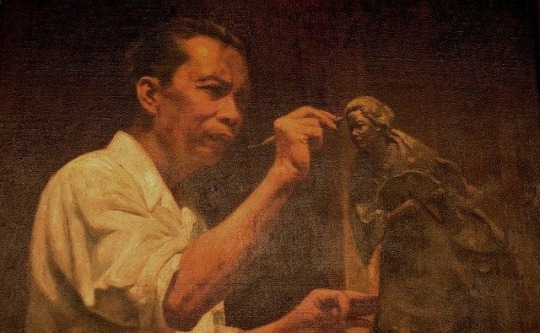
This artist well-known UP School of Fine Arts professor. He brought The Bonifacio Monument into life. He also designed the gold and bronze medals for the Ramon Magsaysay Award and did the seal of the Republic of the Philippines.
Besides monuments, Tolentino made smaller sculptures, which are now located in the National Museum of Fine Arts and busts of heroes at the Malacañang Palace. He also designed the medals of the Ramon Magsaysay Award and the seal of the Republic of the Philippines.
In 1970, he was also conferred the President's Medal of Merit for contributions to nation building through his outstanding work in arts particularly in sculpture. Tolentino also received the Republic Cultural Heritage Award in 1967 for his contribution in preserving, developing, and enriching the Filipino culture.
Artwork of Guillermo Tolentino
The Bonifacio Monument in Caloocan.
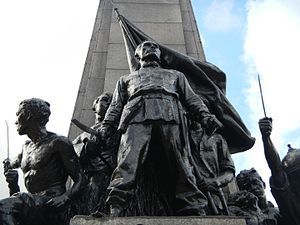
Napoleon "Billy" Veloso Abueva (January 26, 1930 – February 16, 2018)

Napoleon "Billy" Veloso Abueva, more popularly known as Napoleon Abueva, is a Filipino artist. He is a sculptor given the distinction as the Philippines National Artist for Sculpture. He is also entitled as the “Father of Modern Philippine Sculpture”. He is the first and only Boholano given the distinction as National Artist of the Philippines in the field of Visual Arts.
He is not only the Father of Modern Philippine Sculpture but also is the youngest recipient of this award. He also used many forms of materials in his craft.
Abueva helped shape the local sculpture scene to what it is now. He used almost all kinds of materials for his sculptures such as hard wood, adobe, metal, stainless steel, cement, marble, bronze, iron, alabaster, coral and brass.
Artwork of Napoleon Abueva
The Transfiguration
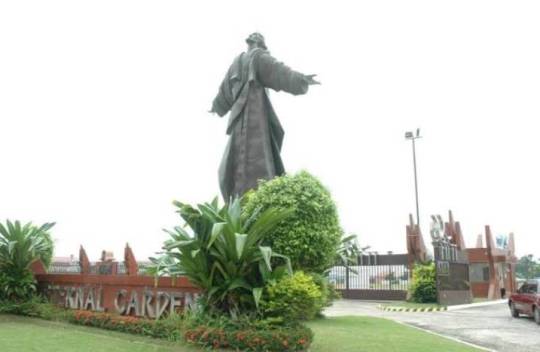
Victorio Candido Edades (December 23, 1895 – March 7, 1985)
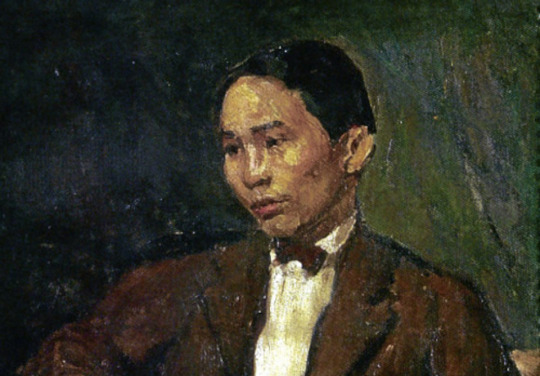
Edades is tagged as the Father of Modern Philippine Painting. He is known for his dark and subdued shades in his art pieces.
As a painter, Edades is recognized for revolutionizing the art of modern painting, thus earning for himself the title of “Father of Philippine Modern Art.” With his modernist paintings like his masterpiece, The Builders, and his tireless effort as an educator, Edades was declared a National Artist for Visual Arts in 1976. His legacy to Philippine art is a valuable contribution to the continuing evolution of the country’s culture.
His masterpiece, "The Builders," was characterized by strong composition and dark colors. Edades introduced modern art to the Philippines when it was still largely a conservative society. The public was not ready to appreciate his works, and not one of his paintings was sold.
Artwork of Victorio Edades
The Builders

2 notes
·
View notes
Text
Private Armies of Mindanao
From Filipino Free Thiners
Private Armies of Mindanao
Faraj Pangeran
April 2, 2010
The Rise of Private Armies
Ever since the brutal slaughter in Maguindanao, it raised again the issue of private armies. Private armies exist everywhere in the Philippines and was an issue as far back as the early years of the American colonial regime in the Philippines. After independence was re-established in 1946, private armies were seen as essential to safeguarding the republic from the Huks. Since that time, private armies were seen more of a blessing to Malacanang Palace with the exception of Ramon Magsaysay who saw private armies not only as a lawless element but a threat to military readiness. According to the Philippine National Police, there are over 170 private armies in the Philippines and about 68 are found in the Autonomous Region of Muslim Mindanao (ARMM).
Land Struggles
The genesis of private armies in Mindanao can be traced to the discrimination experienced in the land system. Since time immemorial, both Lumads and Moros had a communal land system which meant that essentially as long as one took care of a piece of land, it was yours. When there was a dispute, a datu, chief, or sultan settled it for you and created a deed or edict.
With the establishment of American rule in Mindanao, a new land tenure system was imposed. This included “nationalizing” (really confiscating) ancestral communal lands of the Lumads and Moros into “public lands” under the Public Land Law of 1903. Lumads and Moros now had to register their land claims in Spanish or in English to the American authorities either in Zamboanga or in Manila and non-Christians were allowed only to claim up to 10 hectares while Christians could claim up to 16. It also voided any deeds or land claims made by sultans, chiefs, and datus. Furthermore, all Moros, Lumads, Igorots, and Aetas came under the supervision of the Bureau of Non-Christian Tribes of the Department of the Interior under the Governor-General. This meant in certain circumstances, a Moro or Lumad needed permission to even apply for a land title from the Bureau of Non-Christian Tribes. With the Public Land Act No. 2874, enacted in November 1919, this was increased to 24 hectares. At the same time, Moros and non-Christians were only allowed to claim up to 8 hectares. The amended public land law of 1936 reduced the homestead size back to 16 hectares, and cut the land claims for Moros and non-Christians to four hectares.
What this essentially did was not only to strip away the ancestral domains of Moros, Lumads, and every other indigenous group in the country, but made religion even a basis to gaining a land title. It also became a land bonanza for American corporations (i.e., Dole, Goodyear, etc.) and Filipino landed families including the Cojuancos, the Arroyos, and many others.
Beginning in 1912, landless peasants from the Visayas and Luzon were shipped to Mindanao and allowed easy access to claim land while Lumads and Moros were forcibly put into re-settlement programs on non-agricultural lands and monitored by the Philippine Constabulary. Christians on the other hand were encouraged to settle in the more productive lands especially along the coasts and corporations were given tax breaks and other measures to develop in Mindanao. This in turn also attracted a number of landed families particularly from Cebu and Manila who saw the opportunities, in particular, logging and mining.
Since technically a Christian person could only claim a certain amount of land, what some Filipino politicians and landlords in the Visayas and Mindanao did was to have their workers claim the land that they wanted, have their connections in Manila process the claim, and then the worker would “sell” that claim to them. Sometimes the workers were not even aware that they had even processed a claim. In this way, some families were able to establish huge estates and plantations in Mindanao without being in violation of the Public Land Laws.
This was compounded with the fact that Moros and other “non-Christians” could not vote, which is one of the reasons why there were no elected Moro, Lumad, Aeta or Igorot politicians during the Commonwealth. The non-Christians were supposedly represented through the Bureau of Non-Christian Tribes which were always staffed by Roman Catholics and never headed by a non-Christian.
During the resettlement programs under Magsaysay, Garcia, and Macapagal settlers were given land for free or simply had to pay a processing fee. These factors are actually the root of the conflict in Mindanao.
In the 1950s, friction began to occur not with just the indigenous populations of Mindanao and the new settlers but between competing politicians. Malacanang began to see the potential of Mindanao in giving that extra–often controversial–votes during elections; private armies had enjoyed support from whomever was president who naturally also came from a political dynasty. Thus, private armies in Mindanao had a two fold purpose: to maintain the political and economic power of political dynasties; and to legitimize the land claims of Christian settlers. In turn, this also would ensure that Mindanao would be part of the Philippine nation-state–something that many Moros still contest–and eventually be “Christianized”. In addition, there were new problems arising from the rise of Communism which gave the Armed Forces of the Philippines an excuse to supply private armies as a counter-insurgency measure.
Generally speaking, warlordism is most pronounced in Sulu, North Cotabato, Davao provinces, Lanao del Sur, South Cotabato, Surigao, Zamboanga, South Cotabato, Sarangani, and Sultan Kudarat–all areas where competition for agricultural land and natural resources is very high. Except for Sulu, North Cotabato, Lanao del Sur, and Sultan Kudarat, these private armies have been recognized at one time or another as a CVO or CAFGUs and are all employed by mining companies, plantations, and/or political dynasties.
Some of the more well known private armies in Mindanao include the Kuratong Baleleng of Ozamis City Mayor Ronaldo O. Parojinog. The Kuratong Baleleng was also instrumental in both Aquino and Estrada’s all out war in Minandao. In North Cotabato vice Governor Emmanuel Piñol maintains another private army. His private army includes its own factory in Mlang and produces mostly M-79 grenade launchers and improvised M-14 armalite rifles. North Cotabato Mayor Roger Taliño has several groups registered as Civilian Volunteers Organization (CVOs) and/or Civilian Armed Forces Geographical Units (CAFGUs), which means it received official backing and were given supplies by Armed Forces of the Philippines or directly by the Department of National Defense.
Not to be outdone, Muslim politicians–particularly in areas where land is contentious–began to arm themselves. “The Barracuda”, the private army of the late Lanao del Norte Governor Ali Dimaporo, is one such example. Dimaporo’s army was reputed to have more firearms than three army brigades and would make Ampatuan’s army look like a boy scout troop. Again, it should be remembered that many of these private armies–whether Muslim or Christian–were encouraged and supplied by our own government and therefore our own taxpayers’ money helped to pay for these armies.
Vigilantes and Liberation Fronts
A by-product of these private armies and the land situation led to the formation of the various Moro liberation fronts as well as the introduction of the New People’s Army (NPA) and vigilante groups in Mindanao. From a Moro perspective, the loss of land was not just seen as an alienation from one’s ancestral ties but as a deep humiliation. The Sultanates of Sulu, Maguindanao, and Lanao were symbols of resistance to foreign rule. But these sultanates were basically gutted by the Public Land Laws and everything else Moro were belittled by the Commonwealth and later the Republic of the Philippines. This was exasperated by the settler programs in the 1950s and 1960s where over a million people from especially the Visayas region displaced the indigenous populations and became the new majority on lands that were part of the Sultanate. Then to further highlight the position of Moros in the country, the Jabidah Massacre occurred in 1968 where 28 Moro recruits were executed by the Armed Forces of the Philippines (AFP) after the AFP decided to abandon its plan to invade Sabah and destablize Malaysia.
The MNLF
In light of all of this, the Moro National Liberation Front (MNLF) was formed in the 1970s and began waging a protracted war for independence. The chairperson of the MNLF, Dr. Nur Misuari, was a former professor at the University of the Philippines-Diliman and had been a member of the Kabataan MakaBayan (KMB) of Jose Sison. The KMB members later formed the nucleus of the leadership of the Communist Party of the Philippines.
Since the beginning of the armed struggle, the MNLF made it clear that their main issues in Mindanao were not religious in nature but were for self-determination and for the social and political inequalities that existed not just in Philippine society but within the BangsaMoro themselves. In the late 1970s as the MNLF began to spread through the Moro majority areas of Mindanao, the Communist Party of the Philippines at the same time began operations in non-Muslim areas in Mindanao.
This in turn led further government support of CAFGUs and escalated the violence, leading to the creation of right wing Christian vigilante groups whose goal was to wipe out both the Muslims and the Communists. These included the Alsa Masa, NAKASAKA, Causa Manifesto, Tadtad, and the Davao Death Squads. The Tadtad group was infamous for its practice of ritual cannibalism and keeping the ears of their victims as souvenirs.
Despite all of this, these groups got official approval not only from the government but also from the Roman Catholic Church who refused to condemn the killings or the death squads. The Auxiliary Bishop of Cebu, Msgr. Manuel Salvador, for example, said in 1986 that ”We really cannot blame these civilians who decide to arm themselves.” Certain other groups were also heavily supported by other Christian churches such as Rev. Sun Myung Moon’s Unification Church, and by anti-communist groups in the US. With the rise of right wing Christian groups, this lead also to the formation of fundamentalist Islamic groups such as the Abu Sayyaf.
One of the Legacies of President Aquino
One of the great ironies of all is that most of these right wing groups–both Christian and Muslim–did not form during the martial law, but during the administration of President Aquino. In 1987, President Aquino praised such groups as a ”concrete manifestation of people power”. The roots of the armed struggle in Mindanao was not originally rooted in religion but in the social inequalities and discrimination until the rise of groups such as the Alsa Masa which occurred during Aquino’s presidency. Likewise, it should be remembered that many of the Muslim politicians like the Ampatuans received their start in politics by being appointed to office by President Aquino and these same people continued to build their private armies with the support of Ramos, Estrada, and Arroyo. Many of these vigilante groups and right wing paramilitary forces still exist today.
The MILF
In 1986, the MNLF and the Aquino administration entered into talks and the MNLF gave up its goal of independence. This gave birth to the Moro Islamic Liberation Front, the Moro National Liberation Front-Reformist, and other smaller groups. The Moro Islamic Liberation Front, in particular, is not secular. It not only believes in BangsaMoro self-determination but also in “Making the Word of Allah Supreme”.
It is also an open secret that the MILF is supported by elements within the Prime Minister’s Office of Malaysia and the Ministry of Foreign Affairs of Malaysia in their special “Moro Desk”. The Malaysian government has a vested interest in the MILF not only because of the Philippine government’s past support of Indonesia during the Konfrontasi but also because the MILF is predominately Maranaw. The MNLF on the other hand traditionally has its mass support from the Tausugs. The Tausugs have claims to Sabah and have been close to Brunei and Indonesia–Malaysia’s rivals. The Maranaw do not have any territorial claims to Malaysia and traditionally have been close to Malaysian royalty. So the struggle between the MNLF and the MILF is not only an ideological struggle (i.e. secular versus Islamic, integration into the Philippine nation-state versus independence, etc.) but also in a way a proxy war between Malaysia and the Philippines over Sabah.
Dismantling the Private Armies
With the outburst of public anger about the massacre in Maguindanao, the current president, Gloria Macapagal-Arroyo, vowed to dismantle private armies. Of course the same sentiments had been said since the time of the Commonwealth. However, the roots of the conflict in Mindanao, the rise of private armies, and the formation of right wing groups are all tied together because it is all based on the social inequalities existing in the entire country (especially regarding land), on the weakness of the judicial system, and to a degree prevailing cultural and religious arrogance. Until there is genuine land reform, genuine electoral reform, a fairer distribution of resources for Mindanao, mutual cultural acceptance, and an efficient, fair and independent judiciary where no one is above the law–the country will always have Communist guerrilla fighters, right wing factions, private armies, and other CAFGUs types.
Originally posted here: https://filipinofreethinkers.org/2010/04/02/private-armies-of-mindanao/
#mindanao#philippines#the philippines#cafgu#paramilitary#anti-communism#counterinsurgency#Gloria Macapagal-Arroyo#politics#aquino#moro#lumad#indigenous people#anti-indigenous
2 notes
·
View notes
Text
Lakbay Sanaysay – Ang Dalampasigan sa Morong
Noong ika-22 ng Mayo, taon 2021 ay pumunta kami sa Morong Bataan. Kasama ko ang aking pamilya noong nagpunta kami sa isa sa mga dalampasigan ng Morong. Maaga akong gumising upang mag-ayos ng aking mga kagamitan na dadalhin sa aking paglalakbay. Matapos iyon ay kaagad na kaming lumisan sa aming tahanan upang magpunta sa aming patutunguhan.

Halos kumulang dalawang oras bago kami makarating sa aming destinasyon. Nang kami ay makarating na, kaagad kaming tumuloy sa aming silid upang ibaba ang aming mga gamit. Tanghali na nang kami ay makarating kaya nagpasya ang aking mga magulang na magtanghalian muna bago kami dumiretso sa dalampasigan. Sa sobra kong pananabik, hindi ko napigilan ang aking sarili at bumaba ako para tingnan ang dalampasigan. Sa aking paglabas ay bumungad saken ang nakakasilaw at nakakasunog ng balat na sinag ng araw. Kasabay nito ang pagsalubong saakin ng napakalakas ngunit napakalambing na yakap ng simoy ng hangin. Maririnig mo rin ang tunog ng mga naghahampasang alon at ang mga ingay ng mga taong masayang nag-e-enjoy sa kanilang pamamalagi sa dalampasigan ng Morong. Ako ay lalong nanabik sa aking Nakita ngunit matapos nito ay kaagad na akong umakyat pabalik upang magtanghalian.
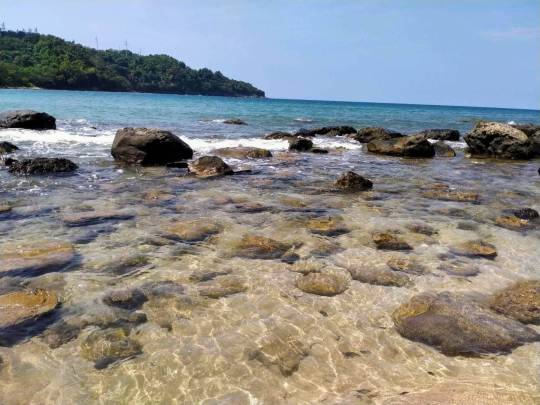
Matapos magtanghalian ay sinabihan kami ng aking ama na magpahinga muna o magpababa ng kinain bago lumangoy at maglaro sa dalampasigan. Labag man sa aking kalooban ay sumunod parin ako dahil ito ang makakabuti saakin. Habang naglilibot sa loob ng hotel, natanaw ko ang mga istante ng libro kung saan nakita ko ang libro tungkol sa kasaysayan ng Morong. Kung titingnan naman natin ang kasaysayan ng Morong, Bataan, ayon sa aking nabasa, ang salitang Morong ay nagmula sa salitang Espanyol na moron. Ang ibig sabihin ng moron ay "isang hangal na tao" o "isang hangal na lugar." Mabuti nalang at sumang-ayon ang Kongreso na palitan ang pangalan ng Moron, Bataan. Si Pangulong Ramon Magsaysay mismo ang naglabas ng Executive Order Blg. 4, na pinalitan ang pangalan ng Moron, Bataan at gawing itong Morong, Bataan. Marami akong natutunan sa libro na iyon ngunit dali dali na akong bumalik sa aming silid dahil baka hinahanap na ako ng aking mga magulang.

Matapos ang pahinga ay bumaba na kami upang enjoyin ang kagandahan ng dalampasigan. Kami ng aking mga kapatid ay naglaro ng buhangin sa tabing dagat. Matapos noon ay naglaro kami sa mga alon. Sumakay rin kami sa bangka kasama ang aking pamilya. Isa sa aking masasabi ay nakakahilo ang mga alon ng dagat kapag ikaw ay nakasakay sa bangka. Ngunit hindi ako nagpatinag sa nakakahilong alon, patuloy parin akong nageenjoy sa aking mga nakikita. Marami akong nakitang mga iba’t - ibang uri at kulay ng isda. May mga nakita rin akong pawikan, kung saan sikat at kilala ang Morong Bataan. Marami rin akong nakitang dikya na palutang lutang lamang sa dagat. Dumaan kami sa isang kweba kung saan ikaw ay pwedeng mag dive at lumangoy sa loob nito. Ngunit dahil sa malalakas na alon ay nagpasya kaming huwag nang bumaba.
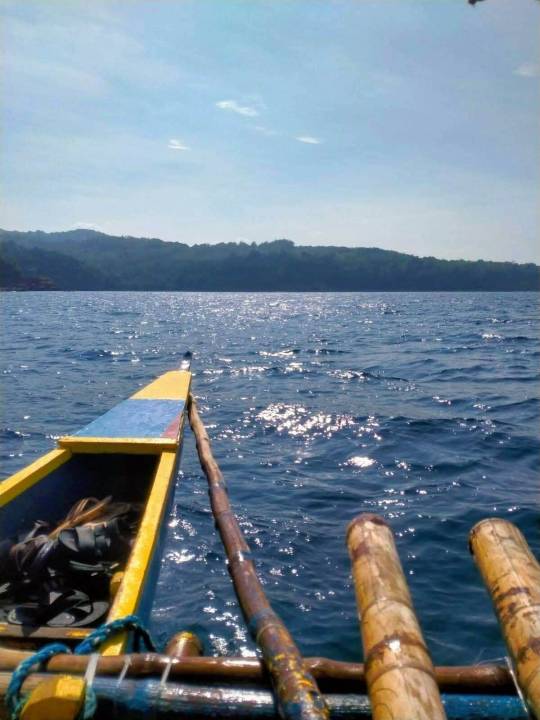

Matapos iyon ay bumalik na kami sa dalampasigan upang masaksihan ang paglubog ng araw. Sa paglubog ng araw, makikita mo ang repleksiyon nito sa dagat na nakapagdaragdag ng kagandahan nito. Ako ay nabighani at namesmerized sa tanawing ito. Pinanood ko ang paglubog ng araw habang dahan-dahan itong nagpaalam saakin. Kumagat na ang dilim at kami ay bumalik na sa aming silid. Sa aking sobrang pagod, agad akong nakatulog ng mahimbing. Hindi man dito nagtatapos ang aking magagandang karanasan, ngunit masaya parin ako dahil marami akong natutunan at naranasan na kalianman ay hindi ko malilimutan.


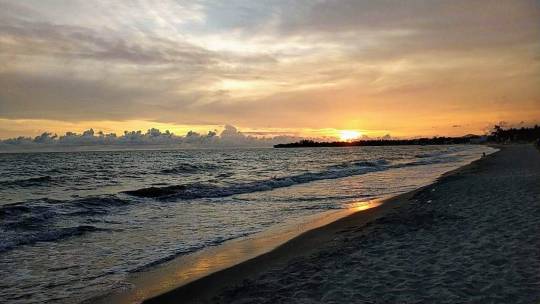
Ang tabing dagat sa Morong, Bataan ay isa lamang sa mga lugar na aking napuntahan na sobrang memorable para saakin. Dito ako unang nakaranas na sumakay ng bangka at marami pang ibang karanasan. Sa aking paglalakbay sa lugar na ito, masasabi kong masaya at nakakapagod ang aking karanasan dito at nais kong bumalik at maulit muli ang karanasan na ito.


2 notes
·
View notes
Text
National Museum of Fine Arts x Ramon Lee Panciteria
I do not frequent the city, I just drop by when I need to. Like my previous post about certain restaurants in Binondo, this was again part of my dad and I's must-visit agenda because we were checking out places he would potentially bring his balikbayan (a Filipino visiting or returning to the Philippines) friends to next week when they arrive. As you have probably figured out, he finds joy in being a local tour guide; history and food just invigorates him. AND fortunate enough for me, I get to experience it too (on the sidelines).
National Museum of Fine Arts
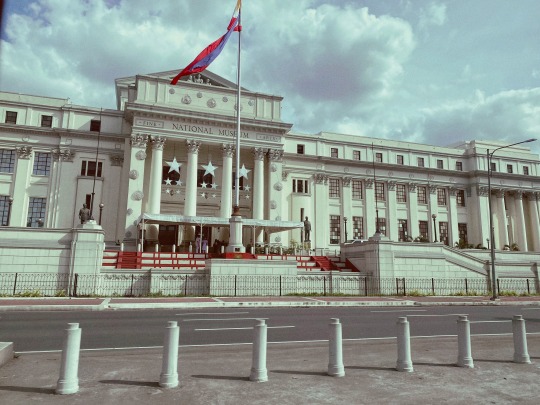
This is the thid time I have visited the National Museum of Fine Arts and it is by far my favorite of all because of the varying collections of paintings and sculptures through different periods of time. It is a place where I could see through dead people's eyes haha I am kidding. To put it less macabre than it actually is, I get to experience history they way these Filipino artists viewed the world during their day. Like my dad, I have a penchant for all things archaic!
But first, kitty duties!

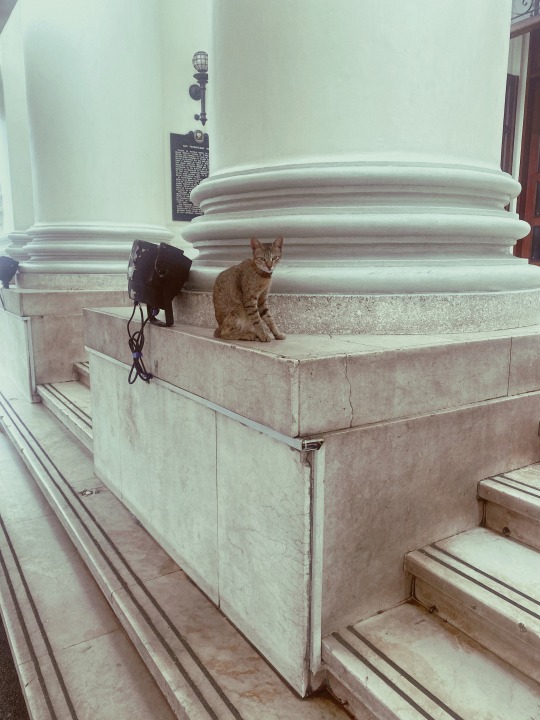
I make it a point to capture cats whenever and wherever I see them! Although these two looked malnourished so it was kind of heartbreaking, I felt even worse that I do not have any food with me. But they have a collar! I am hoping someone IS taking good of them at the very least.



Upon arriving at the museum; passed the security section and registration (did I mention you can enter for free? you just need to present your ID and vaccination card) you will be greeted by this famous and massive masterpiece that is the Spoliarium by Juan Luna. It an exceptionally gory display of the country's fight for prejudice and injustice. If you ask me, the message is still very relatable at present time. It may not be as bloodstained (or is it? as Duterte's EJK come into view) as the colonial period but the struggle for justice and equality still stands strong (or even stronger) today.
Here are some of the pieces that stirred up my emotions:
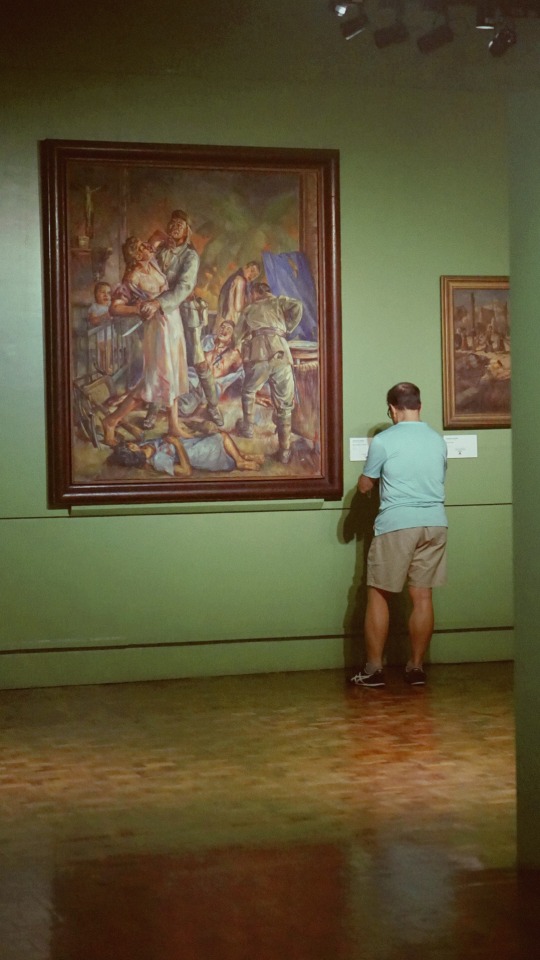
The carnage of the first room. The gallery painted with Japanese torment during WWII was the first collection we viewed and it was a traumatic scene of agony and destruction as so many lives and houses were destroyed during the Japanese occupation. The painter left nothing to imagination - humanity's rawness was on display. I was grateful that I did not live to see that day. Pictures were enough to convince me that men are capable of so much evil when they succumb themselves to senseless warfare.
Anemoia (it sounds like a disease haha) is a term coined by writer John Koenig, and it describes a certain nostalgia for a time you've never known. That is how I feel about the 40s and the 50s era BUT the war was one huge reality that I did not want to come up against.
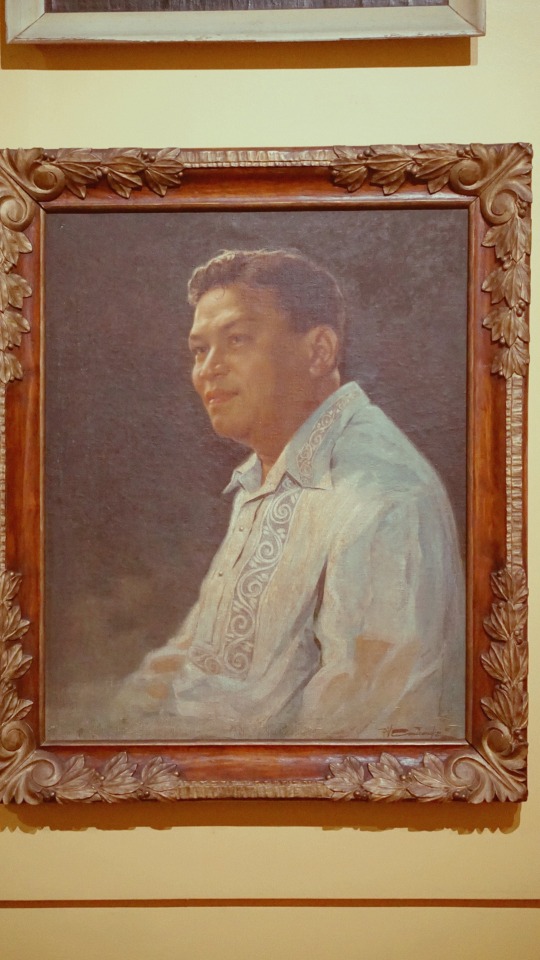
Ramon Magsaysay was the seventh President of the Philippines from 1953 to his death in 1957. I was always curious about this particular leader of ours as history books spoke of him so highly. An author by the name of Jose Veloso Abueva even described his regime as “the yardstick by which Filipino presidents should be judged.”
In this day and age, you search for things from the past to give you strength to tackle the present and give you hope for the future. There was a time when the country was not always like this - a mess (to put it lightly and to make this less of a political post).

The League of Extraordinary Gentlemen. This was a group of scholars who set the foundations for the Philippine Revolution in 1896. They are called the Ilustrados a term used to refer to the Filipino educated class during the Spanish colonial period in the late 19th century. The three most prominent are Dr. Jose Rizal (our national hero), Marcelo H. del Pilar and Mariano Ponce.

While I was going from room to room, I caught a sight of this view from one of the windows. That is the Department of Labor and Employment building on a small hill looking down on the metropolitan city that is Manila. It was surprisingly clean that day which is not a usual occurrence.

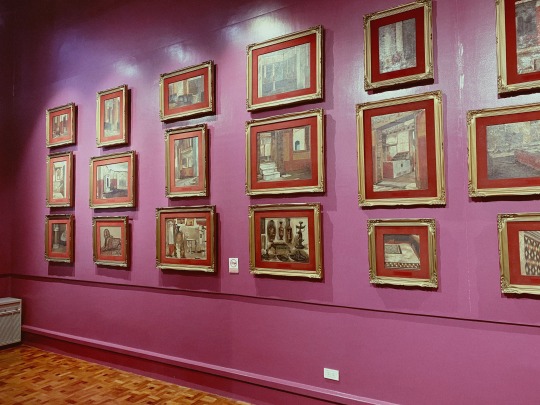
The gallery display of Juan Luna and Félix Resurrección Hidalgo's paintings happens to be my favorite! For me, this was the most approachable collection on a hoi polloi level haha. It exhibited the two artists' work of art during their explorations to different countries like Spain and Italy; it was like a photo album of the places they have been to if you will.

I rested on some occasions! it was an enormous collection divided into three floors.
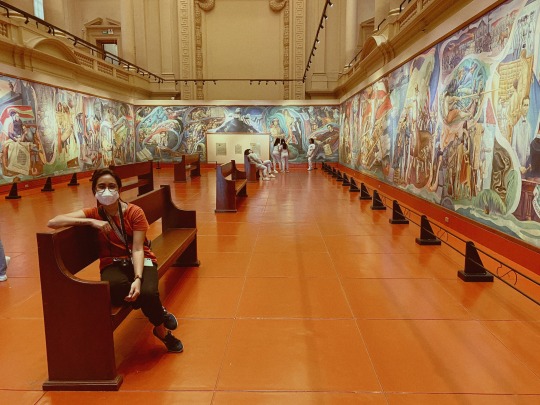
In this photo, I was seated in what used to be the old Senate Senate Session Hall and surrounding it was a mural depicting the history of the Philippines by the National artist, Carlos Botong Francisco.
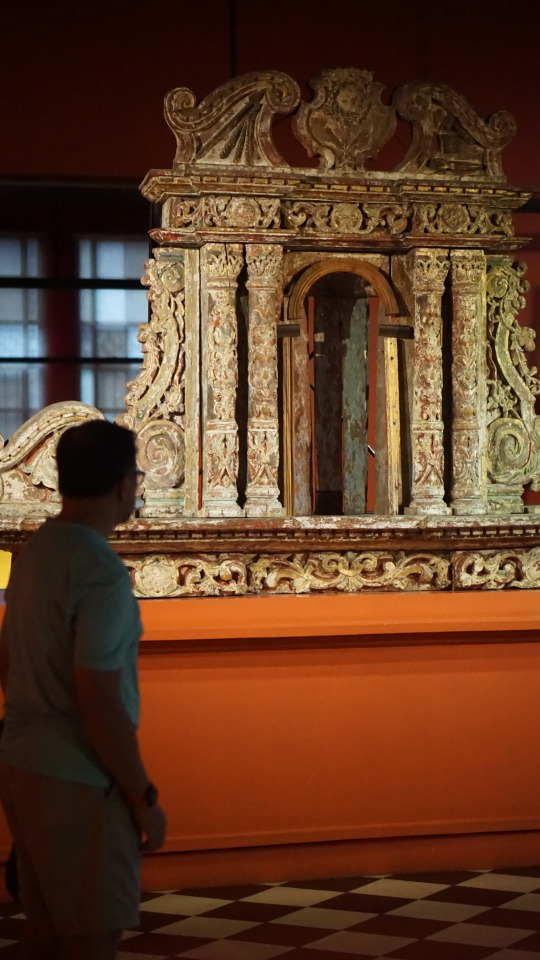
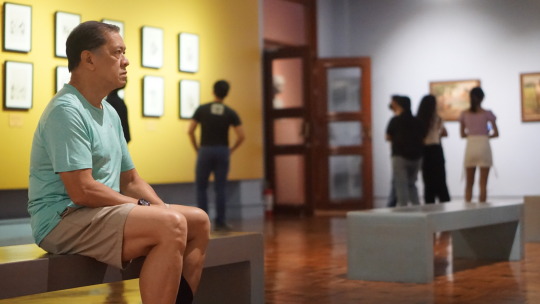

(Just a few of the shots I took of my dad haha as I was asking him to pose for the camera.)
Ramon Lee Panciteria
Settled in between the busy and narrow streets of Sta. Cruz, Manila is one of the oldest restaurants called Ramon Lee Panciteria which has been operating since 1929.



Back in the day, Ramon Lee, a Chinese immigrant and his wife were famously known for serving their Chinese-style fried chicken and pancit canton. Today, the same combo of dishes are still seen on every table. In fact, that was the very dish we ordered.
Like their food from yesteryears, the panciteria's interior gave off the same nostalgic vibe of the 1920s by retaining the original pink cushioned seats and yellow walls.


Fried Chicken (Whole: P450; Half: P230), Pancit Canton Special (P390) and Shanghai Rice (P320)
Everything emanated a very cozy and homey feeling. Food was again unpretentious and huge in portions that dad and I were were able to take home unfinished dishes.
1919 Grand Cafe
To cap off our meal, we embarked on a polar opposite experience.
Nestled in the corner of Juan Luna St. in Binondo is a Neoclassical edifice which houses the repurposed Grand Cafe 1919. In 1922, it was the former HSBC building, a then heritage jewel.


To cut to the chase, I would like to say that their coffee and desserts are the cherry on top of an exciting food trip in Manila.

Muscovado Latte (P180) and Blueberry Cheesecake (P150)
Try it! I am still on the hunt for the snowflake crisp cookie they served together with my coffee! It was just too good that I had a Ratatouille (yes, the Disney animated movie! haha) encounter. The cookie reminded me so much of a delicacy I used to eat when I was a kid called Peanut Broas! Kuhang kuha yung lasa!
#Manila#food trip#Philippines#National Museum of Fine Arts#Ramon Lee Panciteria#1919 Grand Cafe#manilaguide
2 notes
·
View notes
Text
Entry 04

Juan Nakpil
The country’s first National Artist for architecture, Juan Nakpil was born in Quiapo, Manila on May 26, 1899.
In 1954, he became the First Filipino and non-American to be made fellow of the American Institute of Architects. He was the organizer and past president of the Philippine Architects Society, now Philippine Institute of Architects.
Named “Architect of the Year” in 1939, 1940, and 1946, and “Most Outstanding Professional in Architecture” in 1951 by the Philippine Association of Board Examiners, Nakpil was bestowed the gold medal of merit by the Institute of Architects in 1950, the Presidential medal of merit, by President Ramon Magsaysay in 1955, and the Rizal Pro Patria Award in 1972. - bahaynakpil.org
Famous Structures:
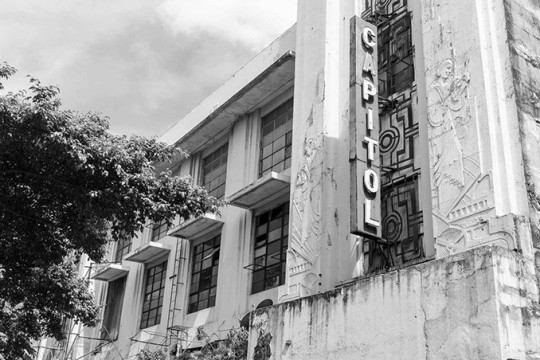
Capitol Theater
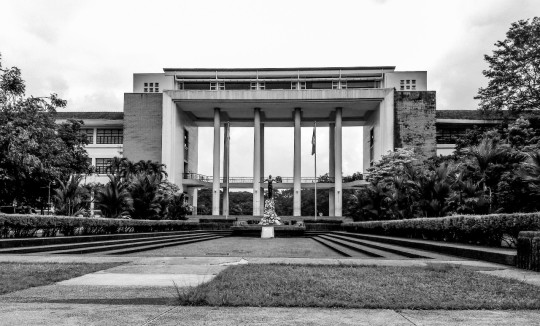
The University of the Philippines-Diliman Administration Building
2 notes
·
View notes